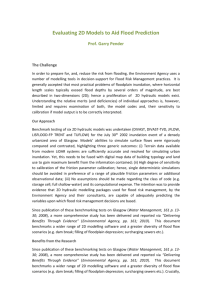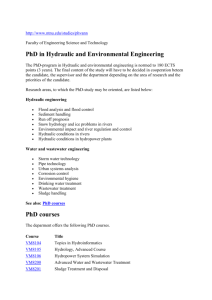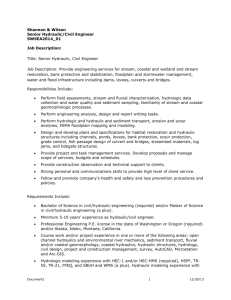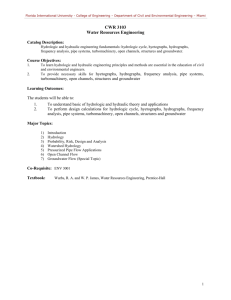BEAP Stage 4 - Department of Defence
advertisement
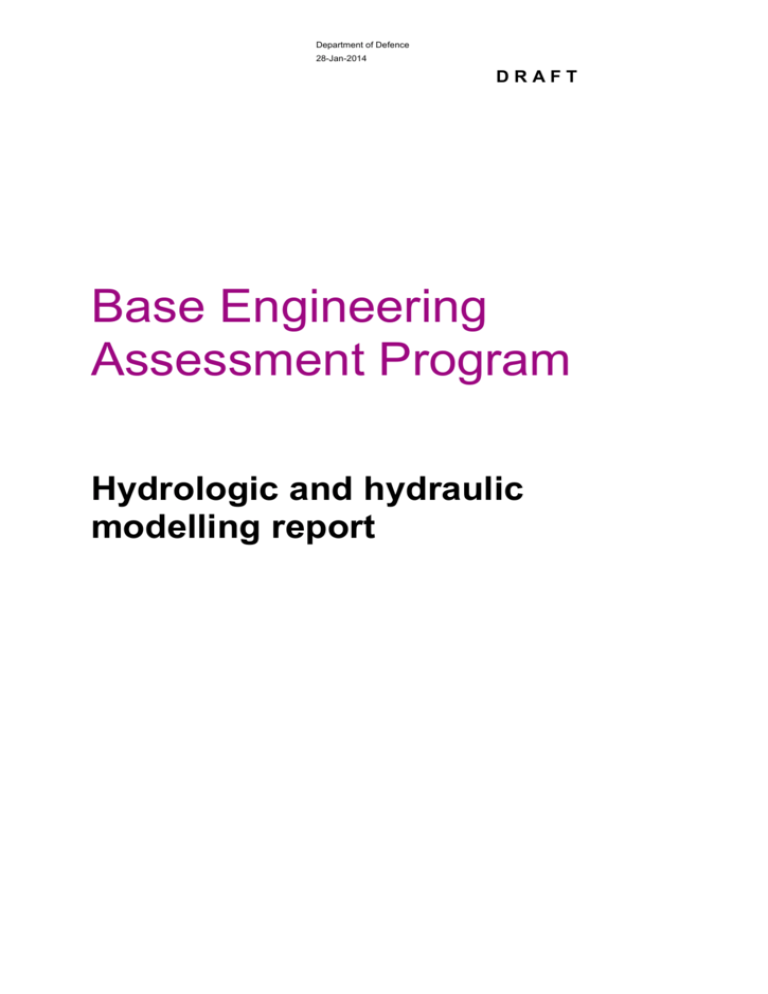
Department of Defence 28-Jan-2014 DRAFT Base Engineering Assessment Program Hydrologic and hydraulic modelling report 116100196 Quality Information Document Ref Date 28-Jan-2014 Prepared by Reviewed by Revision History Revision Revision Date 14-Mar-2012 Authorised Details Name/Position Signature 116100196 Table of Contents 1.0 2.0 3.0 4.0 5.0 Introduction Previous Investigations Hydrologic modelling 3.1 Runoff routing modelling 3.2 Results Hydraulic modelling 4.1 Input data and modelling assumptions 4.1.1 Topography 4.1.2 One-dimensional elements (pipes and structures) 4.1.3 Roughness 4.1.4 Boundary Conditions 4.1.5 Modelling assumptions 4.2 Calibration/Validation 4.3 Results Discussion 1 2 3 3 5 6 6 6 7 8 9 9 9 9 11 List of Figures Figure 1 Figure 2 Figure 3 Figure 4 Figure 5 Figure 6 Figure 7 Figure 8 Figure 9 Figure 10 Figure 11 Site location Hydrologic model layout Locations of hydrographs Hydraulic model layout Hydraulic model one-dimensional elements Hydraulic model roughness grid Hydraulic model boundaries 1% AEP flood event maximum flood depths 1% AEP flood event maximum flow velocities 10% AEP flood event maximum flood depths 10% AEP flood event maximum flow velocities 1 4 5 6 7 8 9 10 10 10 10 List of Tables Table 1 Table 2 Table 3 Table 4 Table 5 Table 6 Table 7 Intensity Frequency Duration (IFD) data Peak flows for various storm durations. Site drainage details Structure details TUFLOW pipe model factors Manning’s “n” roughness values Hydraulic model boundaries 3 5 7 7 7 8 9 116100196 1.0 Introduction Brief intro to the site. Comment on the location, upstream catchment, site slopes, local drainage, historic flooding, etc Figure 1 shows the site location. Figure 1 Site location INSERT FIGURE 116100196 2.0 Previous Investigations List any previous hydrologic or hydraulic investigations. 116100196 3.0 Hydrologic modelling Hydrologic modelling was undertaken using two different techniques. A runoff routing model was used to determine the external flows entering the site and rainfall on grid was used to represent rain falling on the study area. The following flood events were modelled: -1% AEP -10% AEP -etc 3.1 Runoff routing modelling Runoff routing modelling was undertaken utilising existing/new RAFTS/WBNM/RORB models created for ?? project. It included the following input data: -Catchment delineation based on ….. -Fraction impervious based on …. Table 1 shows the IFD data that was utilised for this model (EASTING and NORTHING coordinates). Please note that this is based on the 1987 IFD data. Table 1 Intensity Frequency Duration (IFD) data Variable Value 1 hour, 2 year ARI rainfall intensity xx mm/hr (1 I 2 ) 12 hour, 2 year ARI rainfall intensity (12I 2) 72 hour, 2 year ARI rainfall intensity (72I xx mm/hr xx mm/hr 2) 1 hour, 50 year ARI rainfall intensity xx mm/hr (1I50) 12 hour, 50 year ARI rainfall intensity (12I 50) 72 hour, 50 year ARI rainfall intensity (72I xx mm/hr xx mm/hr 50) F2 xx F50 xx Skewness (G) xx (ref: http://www.bom.gov.au/water/designRainfalls/ifd/index.shtml) Figure 2 shows the hydrologic model layout. 116100196 Figure 2 Hydrologic model layout INSERT FIGURE SHOWING HYDROLOGIC MODEL LAYOUT This model was calibrated to the following: -Historic event -Rational method calculation… This modelling was based on the following assumptions: -Fraction impervious values -Initial loss = xx mm -continuing or proportional loss = yy mm/hr or zz% -storages -routing -other factors 116100196 3.2 Results Hydrographs were extracted from the hydrologic model at several locations. Figure 3 shows the location of these hydrographs. Figure 3 Locations of hydrographs INSERT FIGURE SHOWING LOCATIONS WHERE HYDROGRAPHS WERE EXTRACTED Table 2 shows the peak flows at these locations for various storm durations. Table 2 Peak flows for various storm durations. Location 15 min storm event 20 min storm event 25 min storm event 30 min storm event 45 min storm event 1 hour storm event 1.5 hour storm event 2 hour storm event 3 hour storm event A B C D E F G H I J K L M N Based on the results in the above table, hydrographs for the xx duration storm event/s have been extracted from the hydrologic model and used as inflow boundaries for the hydraulic modelling. 116100196 4.0 Hydraulic modelling Hydraulic modelling for this site was undertaken utilising TUFLOW software. This section describes the modelling undertaken for this investigation. This model has the following components: -Two-dimensional grid representing the ground surface elevations (topography) -One-dimensional elements representing the underground pipes and structures -Rainfall on grid 4.1 Input data and modelling assumptions 4.1.1 Topography A two-dimensional grid was developed for the area shown in Figure 4. This figure also shows the ground surface levels used in this modelling. These ground surface levels were based on the following data: -LiDAR (reference) -Additional ground survey? -Any other info? A x metre grid spacing was used for this model. Figure 4 Hydraulic model layout INSERT FIGURE SHOWING HYDRAULIC MODEL EXTENT AND GROUND ELEVATION. 116100196 4.1.2 One-dimensional elements (pipes and structures) Table 3 includes the details of the site drainage components. Some of these were modelled as one-dimensional elements, others were represented in the two-dimensional grid. Figure 5 shows the location of the onedimensional elements. Table 3 Site drainage details Length/number Comments Open drains Xx km Modelled as 1D or 2D elements? Underground pipes Xx km ranging in size from x mm to y mm diameter Structures Number of culvert/bridge structures Table 4 shows details of the structures represented as one-dimensional elements. Table 4 Structure details Reference Description Configuration Data source A Eg. Xx road crossing of yy drain Size of culverts or description of bridge (eg single span), Eg GIS data, site inspection, previous work B C D E F G Table 5 shows the factors that should be used for the representation of pipes and culverts in TUFLOW. Table 5 TUFLOW pipe model factors Variable Value Entry loss 0.5 Exit loss 1.0 Height contraction coefficient 0.6 Width contraction coefficient 1.0 for RCP’s 0.9 for RCBC’s Figure 5 Hydraulic model one-dimensional elements INSERT FIGURE SHOWING PIPES AND STRUCTURE LOCATIONS 116100196 4.1.3 Roughness Table 6 shows the Manning’s ‘n’ roughness values that were adopted for this investigation. Table 6 Manning’s “n” roughness values Description Manning’s ‘n’ value Open space X Roads X Heavily vegetated areas X Buildings X Etc X Pipes and culverts X Figure 6 shows the roughness grid used for this modelling. Figure 6 Hydraulic model roughness grid INSERT FIGURE SHOWING ROUGHNESS GRID 116100196 4.1.4 Boundary Conditions Table 7 details the boundary conditions that were utilised for this investigation. Figure 7 shows the location of these boundaries. Table 7 Hydraulic model boundaries Boundary location Type Details Explain location (eg xx creek inflow) QT Hydrograph xy from RAFTS model Explain location (eg xx creek inflow) QT Hydrograph xy from RAFTS model Explain location (eg xx creek inflow) QT Hydrograph xy from RAFTS model Downstream boundary (Creek name) HT or HQ Values or reference Rainfall on grid Hyetographs to be developed based on IFD data in Table 1. Initial loss = xx mm Continuing loss = yy mm/hr Figure 7 Hydraulic model boundaries INSERT FIGURE SHOWING LOCATION OF HYDRAULIC MODEL BOUNDARIES 4.1.5 Modelling assumptions The following modelling assumptions were incorporated in this work: -Time step -Courant number -Eddy viscosity -Any other factors changed from default -Etc. 4.2 Calibration/Validation The hydraulic model was calibrated/validated against the following data: -aaaaa 4.3 Results The hydraulic model was run using the inputs and variables described in this report. The maximum water depths, water surface elevations and maximum velocities were processed using TUFLOW –to-GIS and converted to ASCII grids. Figure 8 to Figure 11 show the modelled flood depths and velocities for the site for the 1% AEP and 10% AEP flood events. 116100196 Figure 8 1% AEP flood event maximum flood depths INSERT FIGURE SHOWING LOCATION OF HYDRAULIC MODEL BOUNDARIES Figure 9 1% AEP flood event maximum flow velocities INSERT FIGURE SHOWING LOCATION OF HYDRAULIC MODEL BOUNDARIES Figure 10 10% AEP flood event maximum flood depths INSERT FIGURE SHOWING LOCATION OF HYDRAULIC MODEL BOUNDARIES Figure 11 10% AEP flood event maximum flow velocities INSERT FIGURE SHOWING LOCATION OF HYDRAULIC MODEL BOUNDARIES 116100196 5.0 Discussion Include discussion on: -Model stability -Reliability of results -Areas flooded/not flooded -Summary of flooding on site

